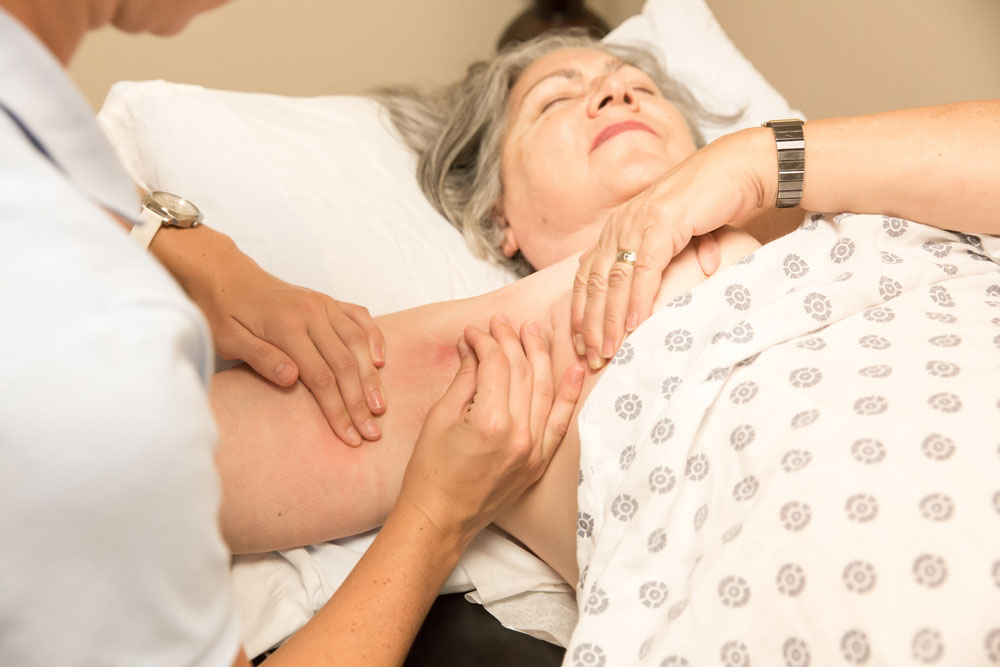
Lymphedema is swelling caused by a build of lymphatic fluid. The lymphatic system is part of the immune system. It maintains the body’s fluid levels and helps the body fight infection. Lymph nodes filter out bacteria, viruses, and waste products; lymphatic fluid (lymph) carries proteins, salts, and the white blood cells necessary for defense. When the lymph vessels are damaged, or lymph nodes are removed, fluid may get trapped in the surrounding tissues and lymphedema can result.
Who Is at Risk for Lymphedema?
Primary lymphedema is a rare genetic condition. Secondary lymphedema is more typical. Patients who have undergone cancer treatment are at risk for secondary lymphedema. This type of swelling can occur after surgery or radiation for any cancer. However, those treated for melanoma or cancer of the breast, head and neck, bladder, ovaries, cervix, penis, or prostate are more likely to be impacted.
What Are the Causes of Lymphedema in Cancer Patients?
- Lymphedema can be a side effect for patients whose lymph nodes were removed during surgery. While removing lymph nodes can prevent the spread of cancer, it can also increase the possibility that lymph will not properly flow.
- Radiation treatment can cause inflammation or tissue scarring, which may damage lymph nodes and obstruct lymph vessels. As a result, the lymphatic system’s effectiveness is diminished.
- Sometimes a cancerous tumor or an increase in white blood cells due to leukemia can cause lymphatic obstruction.
Symptoms may start suddenly or emerge slowly, but they are not always easy to detect. Fluid buildup may occur months, sometimes years, after treatment. Because swelling may also indicate that cancer has come back, it is important to discuss changes with your care team so that appropriate steps can be taken.
Southern Cancer Center recommends an evaluation when there are changes to a patient’s health or vitality.
“Follow-up appointments are routine after cancer treatment but do not hold off on seeing your doctor if new symptoms or changes occur. If lymphedema is diagnosed early, immediate intervention can lessen the severity of some symptoms and prevent them from getting worse,” said Dr. Brittany Case, Medical Oncologist at Southern Cancer Center.
Where Does Lymphedema Occur?
Lymphedema typically occurs in the arms and legs but can present in other areas of the body, such as the neck, face, mouth, abdomen, and groin. The affected area is mainly dependent on the surgical or radiation treatment site.
Symptoms of arm and leg lymphedema may include:
- Swelling or a feeling of heaviness, possibly extending to the fingers and toes
- New aching, tingling, or numbness in the affected area
- Weakness or less flexibility in nearby joints and muscles
- Inexplicably tight-fitting clothes or jewelry, e.g., rings, bracelets, or watches, especially when there hasn’t been an overall weight gain
- Itchy legs and toes
- Burning sensation in the legs
- Taut, shiny, warm, or red skin
- Skin that has thickened or become hard
- Skin that takes on an “orange peel” texture
- Leaking blisters
What Are the Stages of Lymphedema?
Stage 0: Though the lymphatic system may be damaged, swelling is not observed. Some may feel a heaviness or ache in the affected area. This stage can last for months or years.
Stage 1: Swelling is visible but manageable. Swelling can be alleviated by elevating the affected limb or using compression garments. Compression socks and sleeves apply pressure to help maintain blood flow and minimize discomfort.
Stage 2: Skin may or may not indent to the touch. There is moderate to severe skin thickening. Compression and elevation alone will not reduce the swelling.
Stage 3: The skin on the affected body part is thick, dry, and hard; the area is greatly enlarged. The swelling may cause blisters or leakage. Movement is difficult. Stage 3 is permanent.
It is best to seek care during the early stages of lymphedema. The later stages (stages 2 and 3) generally do not respond as well to treatment, and there is an increased risk for secondary infection, such as cellulitis, a bacterial skin infection.
How Can I Manage Lymphedema?
While there is no cure for lymphedema, treatment can help control its progress. A certified lymphedema therapist (CLT) can work with your doctor to develop a plan which may include the following:
- Elevation – a routine schedule for elevating the affected limb to encourage drainage and reduce swelling
- Compression – use of bandages, tape, garments, or devices to maintain gentle pressure, minimize swelling and prevent fluid from refilling in the impacted area
- Skincare – a protocol to reduce the risk of infection. Recommendations typically incorporate a regimen for keeping the area clean and moisturized and guidance on minimizing potential injury. Suggestions might include protection against sunburn and tips for shaving, such as using an electric razor to reduce the chance of cuts.
- Exercise – specific movements to improve range of motion, increase strength, and allow for better flow of lymphatic fluid
- Manual lymphatic drainage (MLD) – a professionally-administered gentle massage that allows fluid to drain into the bloodstream properly
- Complete (complex) decongestive therapy (CDT) – a combination of manual lymphatic drainage, skin care, compression, and exercise directed by your doctor or CLT
Speak to your doctor about other appropriate treatments for lymphedema or antibiotics to prevent secondary infections.
Additional guidance to lessen the risk of developing lymphedema after cancer treatment:
- Maintain a healthy weight
- Avoid crossing legs, sitting, or standing for long periods
- Wear loose clothing without tight elastic bindings
- Limit exposure to severe temperatures, hot or cold
- Do not take blood pressure readings, insert an IV, or draw blood from the affected limb
- Seek immediate medical attention if experiencing skin that is newly hot to the touch, red, swollen, or painful
The doctors and staff at Southern Cancer Center are here to help. Please call 251-625-6896 to speak with one of our care team providers.
Sources:
https://www.medicalnewstoday.com/articles/lymphedema-risk-factors
https://www.cancer.gov/about-cancer/treatment/side-effects/lymphedema/lymphedema-pdq
